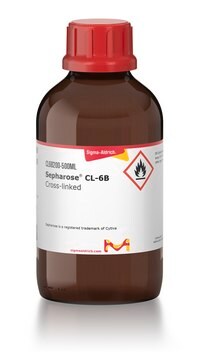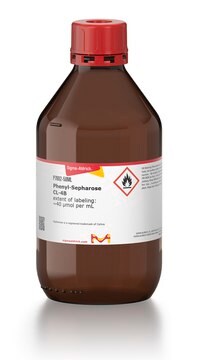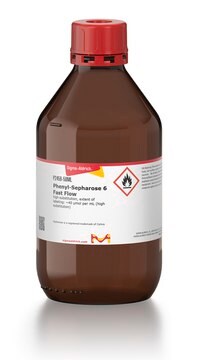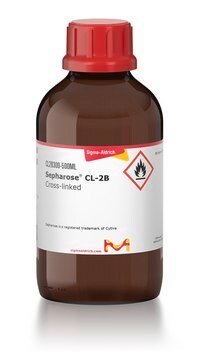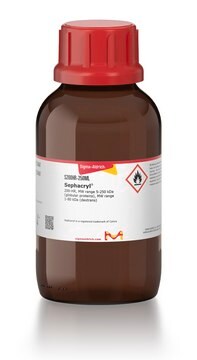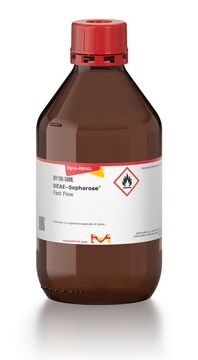CL4B200
Sepharose™ CL-4B Size Exclusion Resin
Cross-linked, 90-350 mesh
Sign Into View Organizational & Contract Pricing
All Photos(1)
About This Item
Recommended Products
Product Name
Sepharose™ CL-4B, Cross-linked
Quality Level
form
beads
technique(s)
LPLC: suitable
matrix
Agarose
matrix active group
polymer
bead diameter
40-165 μm
pore size
30,000-5,000,000 fractionation range (Dextrans)
60,000-20,000,000 fractionation range (Globular proteins)
separation technique
size exclusion (SEC)
storage temp.
2-8°C
Looking for similar products? Visit Product Comparison Guide
General description
CL4B200-1L′s update product number is GE17-0150-01
Application
- Molecular size distribution assessment of Haemophilus influenzae vaccine containing lactose by HPAEC-PAD and colorimetric assays: This study used Sepharose CL-4B in a methodology assessing molecular size distribution in vaccine formulations, indicating its application in quality control and development processes in vaccine production (Nadim AH et al., 2022).
- Camel hydatidosis diagnostic kit: optimization of turnip and horseradish peroxidase conjugates using glutaraldehyde method: This research mentions the use of Sepharose CL-4B in the development of diagnostic kits, suggesting its role in enhancing diagnostic assay development through effective enzyme conjugation techniques (Kandil OM et al., 2020).
- Pectin from leaves of birch (Betula pendula Roth.): Results of NMR experiments and hypothesis of the RG-I structure: Sepharose CL-4B was utilized in the structural elucidation of pectins from birch leaves, underscoring its importance in the structural study of polysaccharides which is essential for understanding their biological functions and industrial applications (Golovchenko VV et al., 2022).
Legal Information
Sepharose is a trademark of Cytiva
related product
Product No.
Description
Pricing
replaced by
Product No.
Description
Pricing
Signal Word
Warning
Hazard Statements
Precautionary Statements
Hazard Classifications
Flam. Liq. 3
Storage Class Code
3 - Flammable liquids
WGK
WGK 1
Flash Point(F)
100.4 - 109.4 °F
Flash Point(C)
38 - 43 °C
Choose from one of the most recent versions:
Already Own This Product?
Find documentation for the products that you have recently purchased in the Document Library.
P Argüeso et al.
Cornea, 17(2), 200-207 (1998-03-31)
Our goal was to establish the characteristic migration pattern on sodium dodecyl sulfate-polyacrylamide gel electrophoresis (SDS-PAGE) of high molecular weight mucins from human ocular mucus and the effects of treatment with exo- and endoglycosidases. Chromatography by gel filtration with Sepharose
M Zachariou et al.
Journal of protein chemistry, 14(6), 419-430 (1995-08-01)
The interaction of different species variants of cytochrome c and myoglobin, as well as hen egg white lysozyme, with the hard Lewis metal ions Al3+, Ca2+, Fe3+, and Yb3+ and the borderline metal ion Cu2+, immobilized to iminodiacetic acid (IDA)-Sepharose
Alberta N A Aryee et al.
Applied biochemistry and biotechnology, 168(8), 2105-2122 (2012-10-24)
Grey mullet (Mugil cephalus) lipase was isolated using para-aminobenzamidine agarose and immobilized on octyl Sepharose CL-4B (o-Sep). Immobilized grey mullet lipase (GMLi) had a 10 °C higher optimum temperature compared to the free enzyme and showed remarkable thermal stability. GMLi was
M Downham et al.
Journal of chromatography, 584(1), 59-67 (1992-12-11)
The constant region of human kappa light chain (Ck) was linked to Escherichia coli beta-galactosidase, using standard molecular cloning techniques. The binding of Ck-beta-galactosidase fusions to a number of different murine monoclonal antibodies, specific for Ck, was improved by the
C Srisawat et al.
Nucleic acids research, 29(2), E4-E4 (2001-01-05)
Sephadex-binding RNA ligands (aptamers) were obtained through in vitro selection. They could be classified into two groups based on their consensus sequences and the aptamers from both groups showed strong binding to Sephadex G-100. One of the highest affinity aptamers
Our team of scientists has experience in all areas of research including Life Science, Material Science, Chemical Synthesis, Chromatography, Analytical and many others.
Contact Technical Service